

设计单位 c+d设计中心
项目地点 上海松江
建成时间 2024年7月
用地面积 96平方米
本文文字由设计单位提供。
近日,上海松江醉白池公园边的云间会堂文化艺术中心,举办了一场以“造化——新江南空间艺术”为题的展览。此次展览由同济大学建筑与城市规划学院与上海松江区文化和旅游局联合主办,旨在挖掘江南文化的传统底蕴与现代内涵。
Recently, an exhibition titled “Creation | New Jiangnan Space Art” was held at the Yunjian Huitang Cultural and Art Center beside Shanghai Zuibaichi Park in Songjiang District. The exhibition was jointly organized by CAUP Tongji University and Shanghai Songjiang District Culture and Tourism Bureau, aiming to explore the traditional and modern connotation of Jiangnan culture.
董屹受邀参展,并创作了作品《游目园》。该作品由董屹的空间装置和旅美艺术家吕无咎(1918-2013)的绘画共同构成。
Mr. Dong Yi was invited to participate in the exhibition and created the work “Garden for the eyes”, which consists of a spatial installation by Mr. Dong Yi and paintings by American artist Ms. Lyu Wugiu (1918-2013).
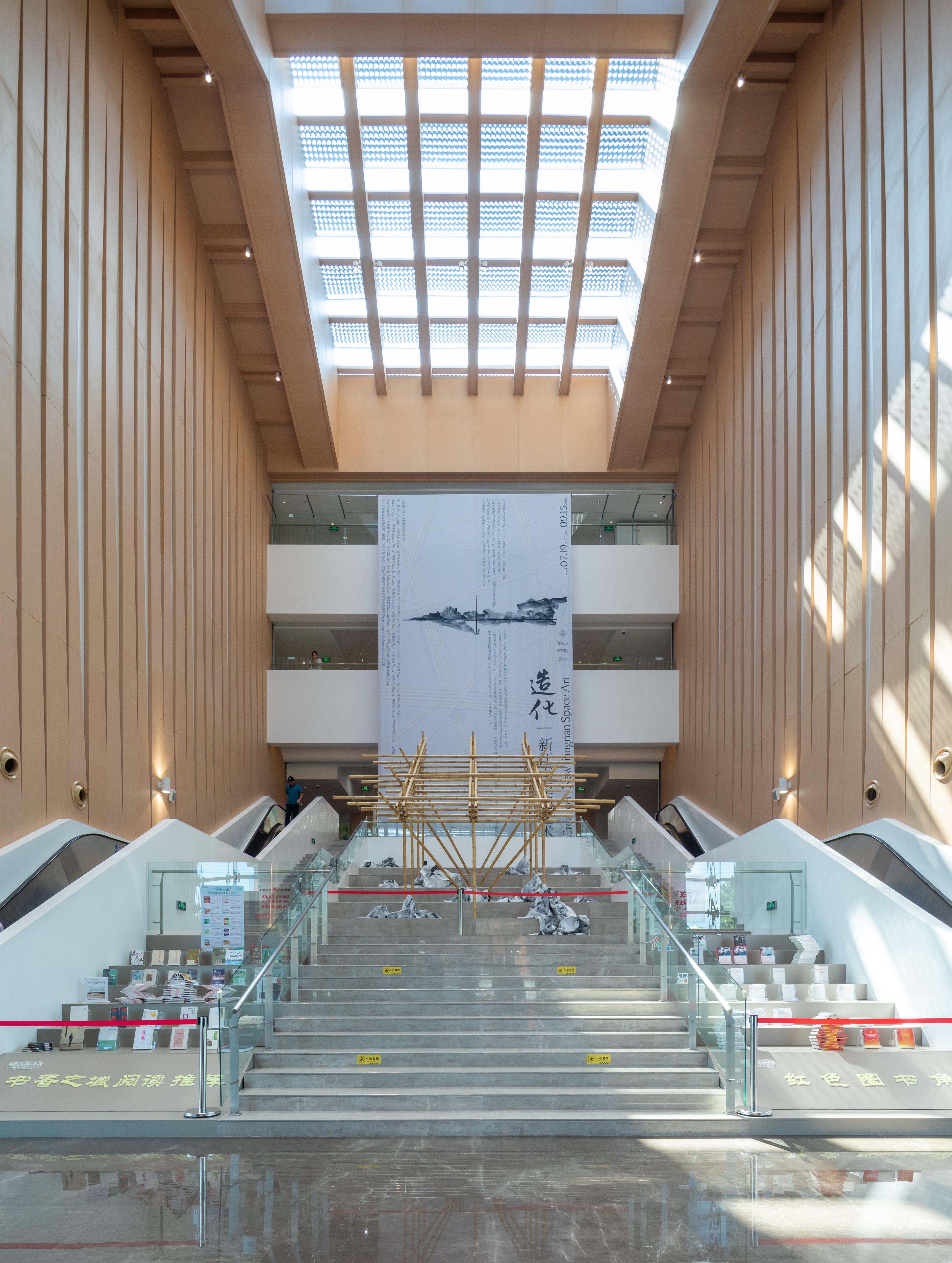
▲ 展览空间视频 摄制:DC国际
在中国文化图景中,作为一个空间概念的“江南”始终是美好生活的重要承载。江南城镇拥有丰富的传统空间,其中的“园林”,无疑是最能体现传统中国人居理想与审美境界的类型。对中国人而言,自成天地的园林是“天与人”的合一,是“市与野”的平衡,是“身与心”的安所。
In Chinese cultural view, “Jiangnan” as a spatial concept has always been an important bearer of wonderful life. Jiangnan towns are rich in traditional spaces, among which the “garden” is undoubtedly the type that best reflects the ideals and aesthetics of the traditional Chinese habitat. For Chinese people, a garden that forms its own heaven and earth is the unity of “heaven and human”, the balance of “city and wild”, and the resting place of “body and mind”.
对于一个受江南文化浸润的建筑师,提到江南,园林几乎是最恰当的表达。于是我们决定以空间装置的方式造一座园,以简素的材质塑造空间的纯粹性,使观游者获得园林空间本质的趣味。
For an architect who has been immersed in the culture of Jiangnan, when it comes to Jiangnan, garden is almost the most appropriate expression. Therefore, we decided to create a garden in way of spatial installation, shaping the purity of the space with simple materials, so that the visitors can obtain the essential interest of the garden space.


展区场地大小只有16米×6米,要在这么小的场地里造一座具有丰富游览体验的园林,几乎是不可能的任务。为此,我们将观游尺度收缩至单人单向,强调以头目动作为主的探索体验,由此营造出一进二出、40米长的游园线路,足以呈现园林空间的曲直、疏密、幽旷,达到“游目足以骋怀”的效果,因此,园以“游目”为名。
The size of the exhibition area is only 16m*6m, which makes it almost impossible to create a garden with rich tour experience in such a small site. For this reason, we condensed the scale of the tour to a single person one-way, mainly emphasizing the exploring experience of the head and the eyes. Thus, we created a 40-meter-long touring route with one entrance and two exits, which was sufficient to present the twists and turns, sparseness and openness of the garden space, to achieve the effect of “Eyes looking around, heart open wide”. Therefore, the garden is named “for the eyes”.

《游目园》通过空间的凝缩将体验集中到感官本身,取“游目骋怀、信可乐也”之意。空间设计源于“醉白池”局部的空间构架,以院、桥、井、廊为基本空间元素,从场景、空间、序列的角度进行重新演绎。
Through the condensation of space, the Garden for the eyes focused its experience on the senses themselves, taking the meaning of “Wandering around and enjoy yourself”. The spatial design was derived from the localized spatial structure of Zuibaichi, taking courtyard, bridge, well and corridor as the basic spatial elements, and reinterpreting from the perspectives of scene, space and sequence.

作品通过对园林尺度的收缩,将人在自然环境中的行为空间进行适应最小人体尺度的转换,抽象重组之后的园林悬于半身高处,仅容一人单向而行。
Through the contraction of the scale of the garden, the work transforms the space of human behavior in the natural environment to adapt to the smallest scale of the human body, and after the abstract reorganization, the garden hangs at the height of upper half of the body, allowing only one person to walk in one direction.


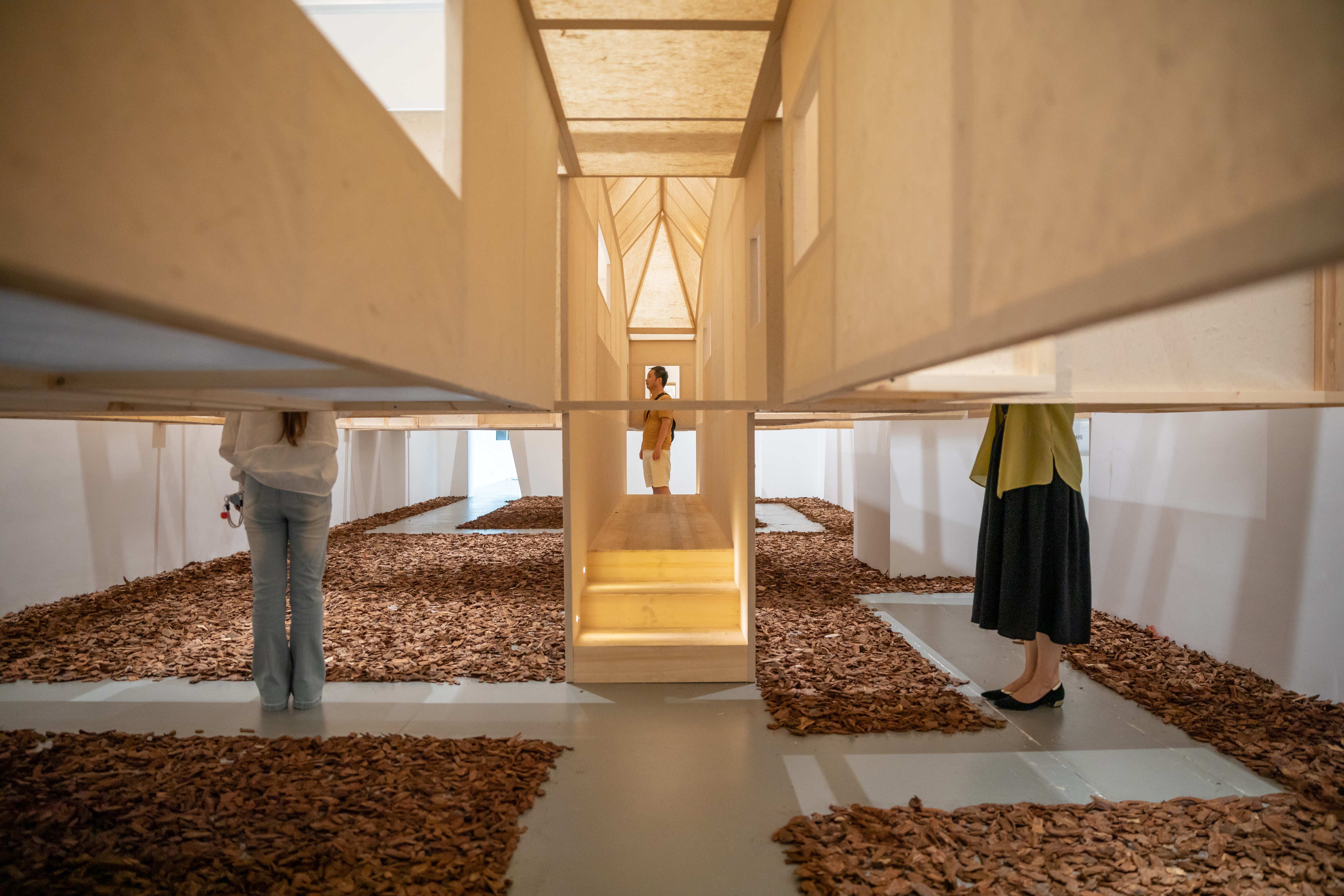
作品将人上半身拢于遮罩之中,院需探首、桥不及膝、井可贴眉、廊仅容肩,由此在行进中可以心无旁骛,以目为身,缓步移动中将对世界的感知汇聚于转头之间。
The upper half of the human body was shrouded in the coverings, where people need to crane their necks to watch the courtyard, bridge lower than their knees, wells close to their eyebrows, corridor barely wide enough for only one shoulder. While wandering in the garden, one can be free from distractions, using eyes instead of body, the perception of the world converging with each turning of his head.



对此作品来说,游目是过程:从无心一瞥到顾盼环视,从虚目远眺到瞠目盈眶,横目可得院之全貌、纵目可随桥之俯仰、侧目可窥井之所藏、极目可穷廊之远方。
For this work, eye-wandering is the process: from an inadvertent glance to looking around, from a distant look to occupying the whole field of vision, the courtyard can be fully viewed from side to side, the bridge can be looked up and down, the hidden well can be found through a casual glance, the depth of the corridor can be measured through a distant watch.



骋怀是结果:身未动,心已远,于转眼之间经开阖之变,于寸尺之间寻园室之趣,于明暗之余得观游之乐。
Mind open wide is the result: the body yet to move, the heart been far away, great changes being experienced in a twinkling of an eye, interest of exploring the garden being experienced between square inches, joy of wandering being experienced between brightness and darkness.
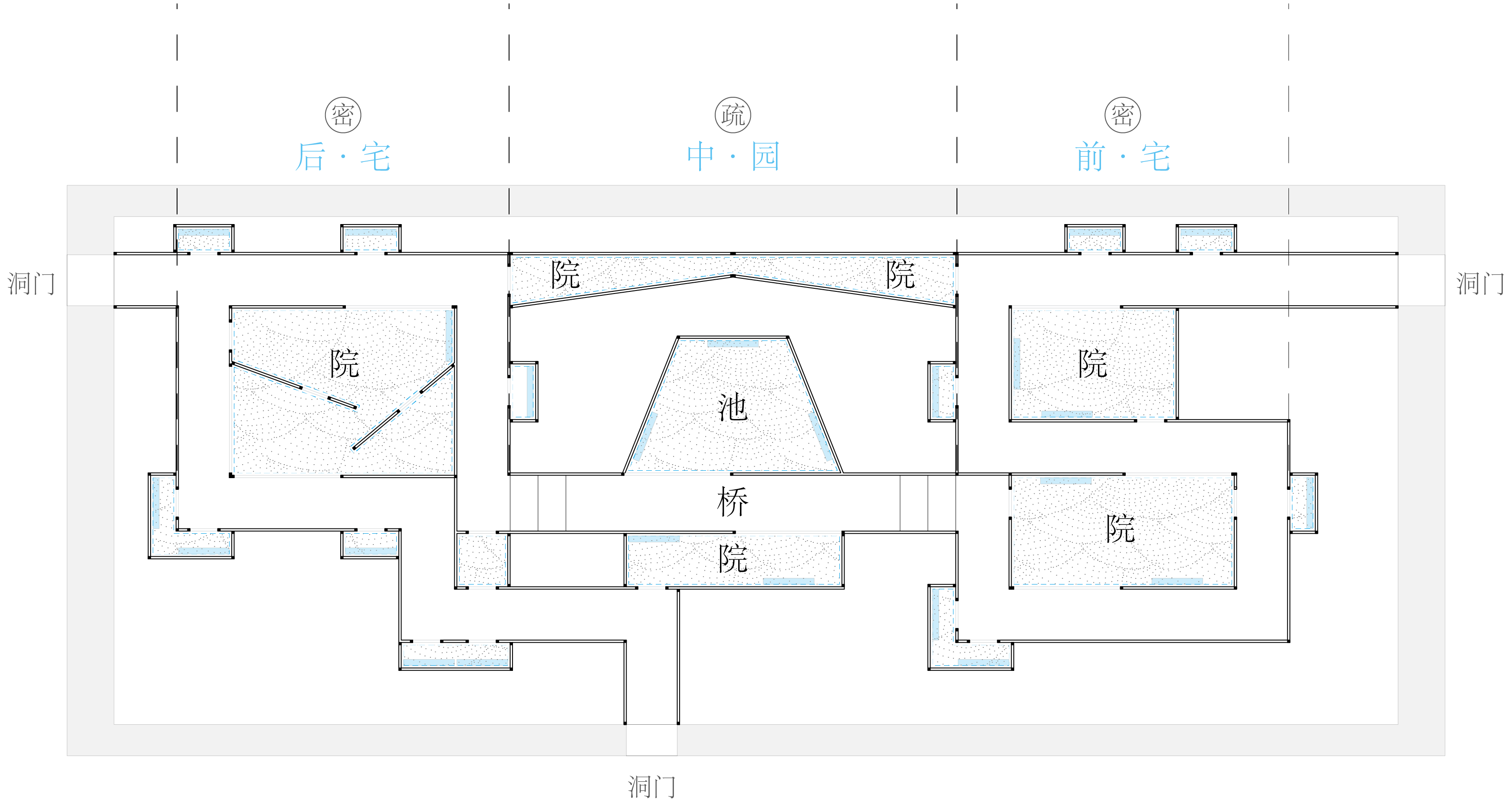
同时,此园既是展品也是另一个层次的展示空间,以园载画,展中有展。园的抽象使空间更为纯粹,将视觉焦点转移到画上,画则成为线索,通过不停的提示和反复引导人对空间的探索。
At the same time, this garden is not only an exhibit but also an exhibition space in another dimension. With paintings presented in the garden, another exhibition contained within the exhibition. The abstraction of the garden makes the space purer, shifting the visual focus to the paintings, which become the clues, guiding people's exploration of the space through incessant hints and repeated guidance.



展出的画作是一套以吴梅村的《鸳湖曲》为题的水墨抽象画复制品(原画目前馆藏于西雅图艺术博物馆。作者生长在江南,后漂泊在外六十余年,在上世纪60年代初开始尝试水墨抽象画,是当代水墨抽象绘画的先驱者之一),共27幅。作者以诗意入画,凭直觉写自己的内心感受,笔墨共情,描写了江南风物的沧桑兴亡,也抒发了深藏心底的江南乡愁。
The paintings on display are a set of reproductions of abstract ink paintings on the theme of Wu Meicun's poem “Yuanhu Qu”, with a total of 27 paintings. (the original painting is currently in the collection of the Seattle Art Museum. The author grew up in Jiangnan, then drifted away for more than sixty years. And she began to experiment with abstract ink painting in the early 1960s, as one of the pioneers of contemporary abstract ink painting) The author painted with poetry, and recorded her inner feelings with intuition. The brush and ink share her feelings, depicting the vicissitudes of the scenery in Jiangnan, and also expressing the nostalgia of Jiangnan that is deeply hidden in her heart.

在这里,抽象的园与画的共同之处在于其对创作过程的展示,“游目园”分解重构了游园的体验经历,“鸳湖曲”则展示了对诗意进行解读的笔墨进程,同时空间成为呈现画作的容器,并将这种呈现的过程以清晰的方式展现出来。
Here, the commonality between the abstract garden and the paintings lies in the display of the creating process. “Garden for the eyes” deconstructed and reconstructed the experience of wandering in the garden, while “Yuanhu Qu” demonstrated the process of ink and brushwork of interpreting the poetry of the poem. At the same time, the space of the garden became a container for presenting the paintings, the process of which was shown in a clear way.


作品对每一幅画作与其所属的空间都进行了定义,通过位置经营,一些画作会在游目过程中多次出现,在远近露藏之间成为游园的向导。
“Garden for the eyes” defined each painting and the space where it belonged to, and through the management of locations, some paintings would appear more than one time in the course of eye-wandering, as a guide to the garden between near and far, exposure and concealment.

行进中每一次转折都是时空场景的重新建构,画作与空间的关系通过不停地重组将空间的叙事和画作的解读融为一体,起承转合之间萦绕着跨越了六十年的淡淡乡愁,共同展现了关于江南的某种抽象记忆。
Every turning in the course of eye-wandering is a reconstruction of the space-time scene. The relationship between the paintings and the space is constantly reorganized to integrate the narrative of the space and the interpretation of the paintings. Between the spatial ups and downs of the garden, lingered the faint nostalgia spanning over sixty years, and the joint exhibition demonstrated some kind of abstract memories of Jiangnan together.
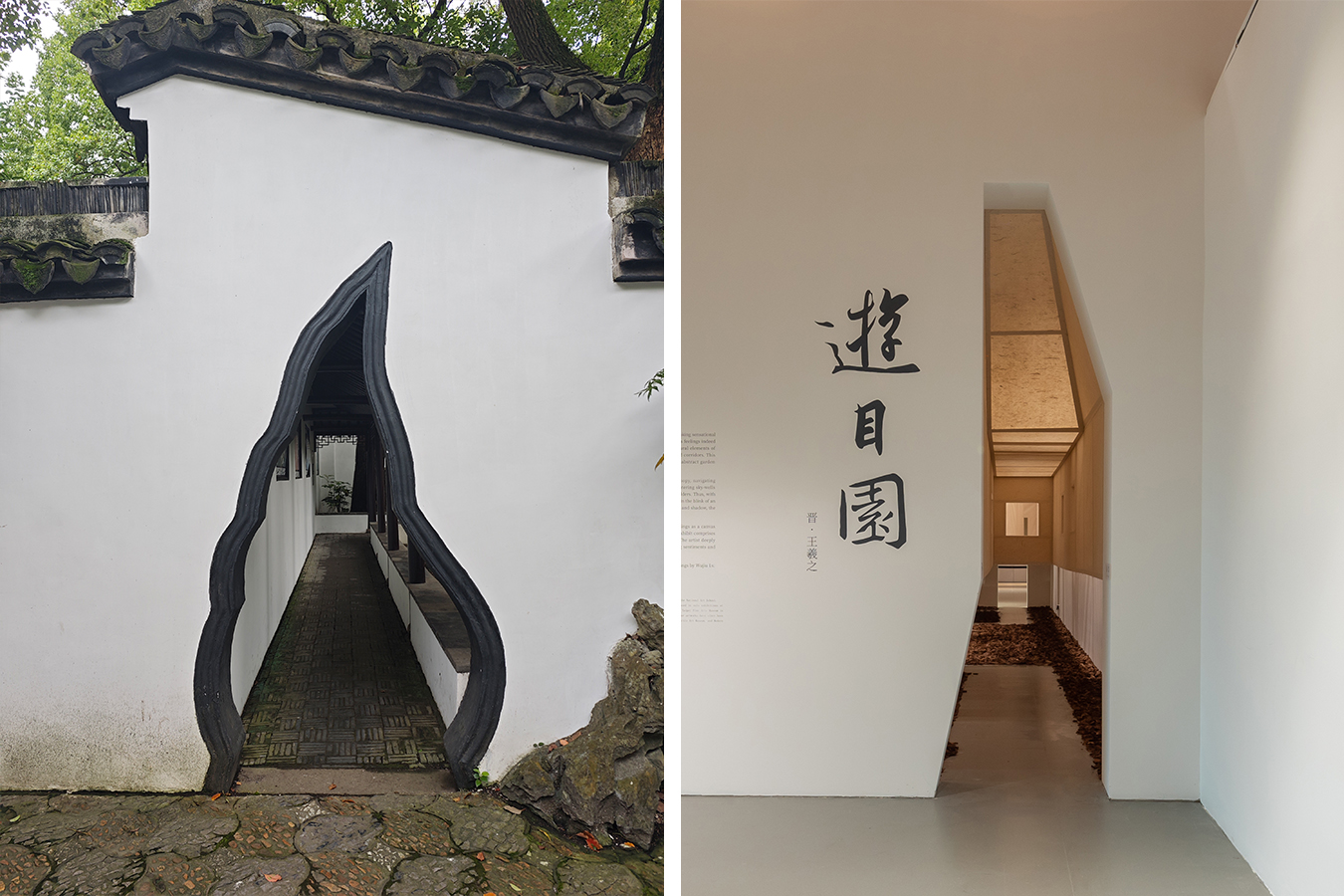
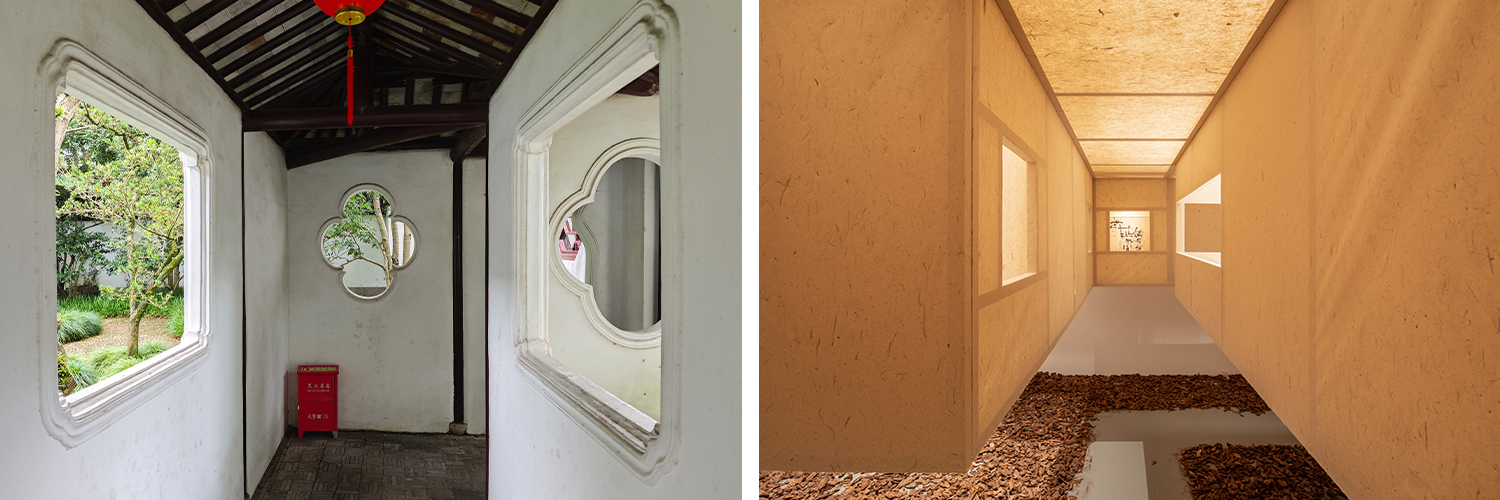
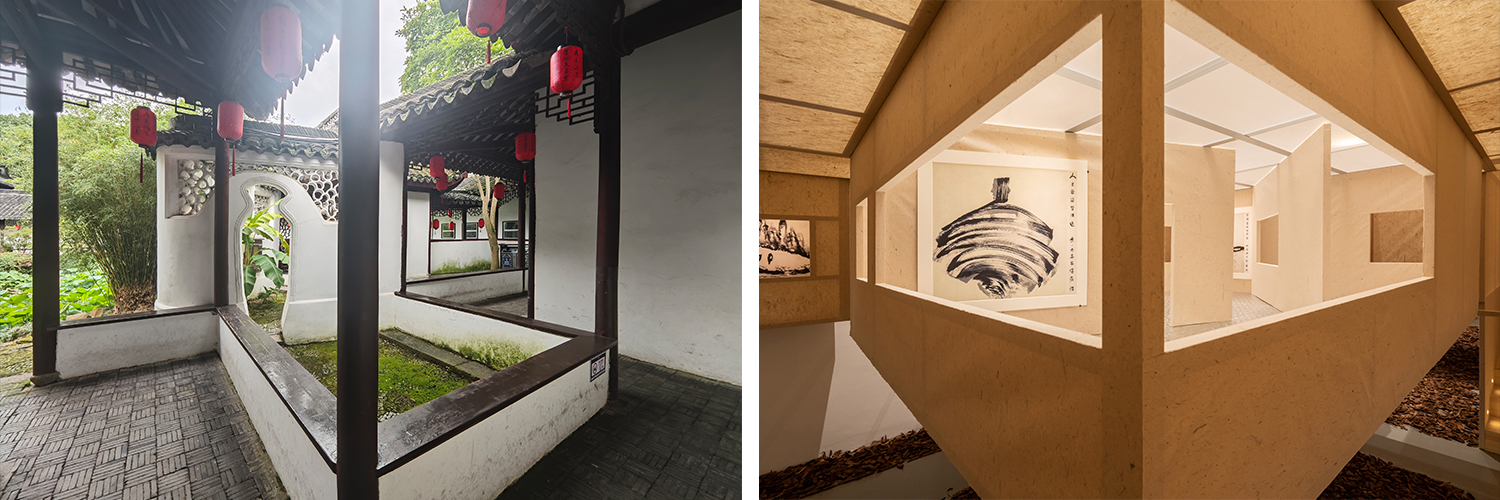
—
材料选择
素以为绚。为了实现抽象园林的艺术效果,材料的选择被控制在极简的程度。整个装置几乎全部由纸构成。手工纸亲近自然的质感,与园林和水墨画的意蕴气质相合。
Simplicity is splendor. In order to achieve the artistic effect of an abstract garden, the choice of materials was kept to a minimalist level. The entire installation is almost totally composed of paper. The texture of handmade paper is close to nature, which is in line with the implication and temperament of the garden and the ink painting.

我们选择安徽泾县生产的手工构皮纸作为空间界面的材料。这种纸,纤维清晰、厚实柔软、透光适当,给人温暖的感觉。纸质轻盈,便于吊挂,可根据展陈需求进行更换和维护。
We chose handmade leatherette paper produced in Jing County, Anhui Province as the material for the spatial interface. This kind of paper has very clear fibers, thick and soft, transmits light appropriately, and gives people a warm feeling. The paper is lightweight, easy to hang, and can be replaced and maintained according to the needs of the exhibition.

装置的框架历经铝型材、竹竿、亚克力等材料的讨论,综合考虑到构造连接的效率、造价、稳定性和质感等因素,最终选择3厘米截面的松木方杆作为空间的骨架。松木质轻,隐于纸后,预制安装方便,吊挂之后不易变形。
The frame of the installation has gone through the discussion of aluminum profiles, bamboo poles, acrylic and other materials, taking into account the efficiency of the construction of the connection, cost, stability, texture and other factors. Finally, we chose square pine poles with the cross-section size of 3cm*3cm as the skeleton of the space. Pine wood is lightweight, concealable behind papers, easy to prefabricate and install, and hard to deform after hanging.


松木框架按照分区被固定在“T”字铝型材上,用细钢索吊挂于上方梁架。“池”和“院”内的“天空”采用半透明pp磨砂片,上方布灯,模拟天光;“地面”用褶皱锡箔纸抽象表达池水波光。松树皮铺陈在地面,勾画出游园的路径,同时也让游者对这个纸作的室内园林,扬起几分野逸的想象。
The pine frames are fixed to the “T” aluminum profiles according to the zoning, and hung from the upper beams with thin steel cables. The “sky” of the “pond” and the “courtyard” is made of translucent pp frosted sheet, with lamps above to simulate the sky light; the “Ground” is made of folded tin foil to abstractly represent the water of the pond. Pine bark is spread on the ground, outlining the path of the garden, and at the same time, raising a few wild imaginations of visitors for this indoor garden which is made of paper.
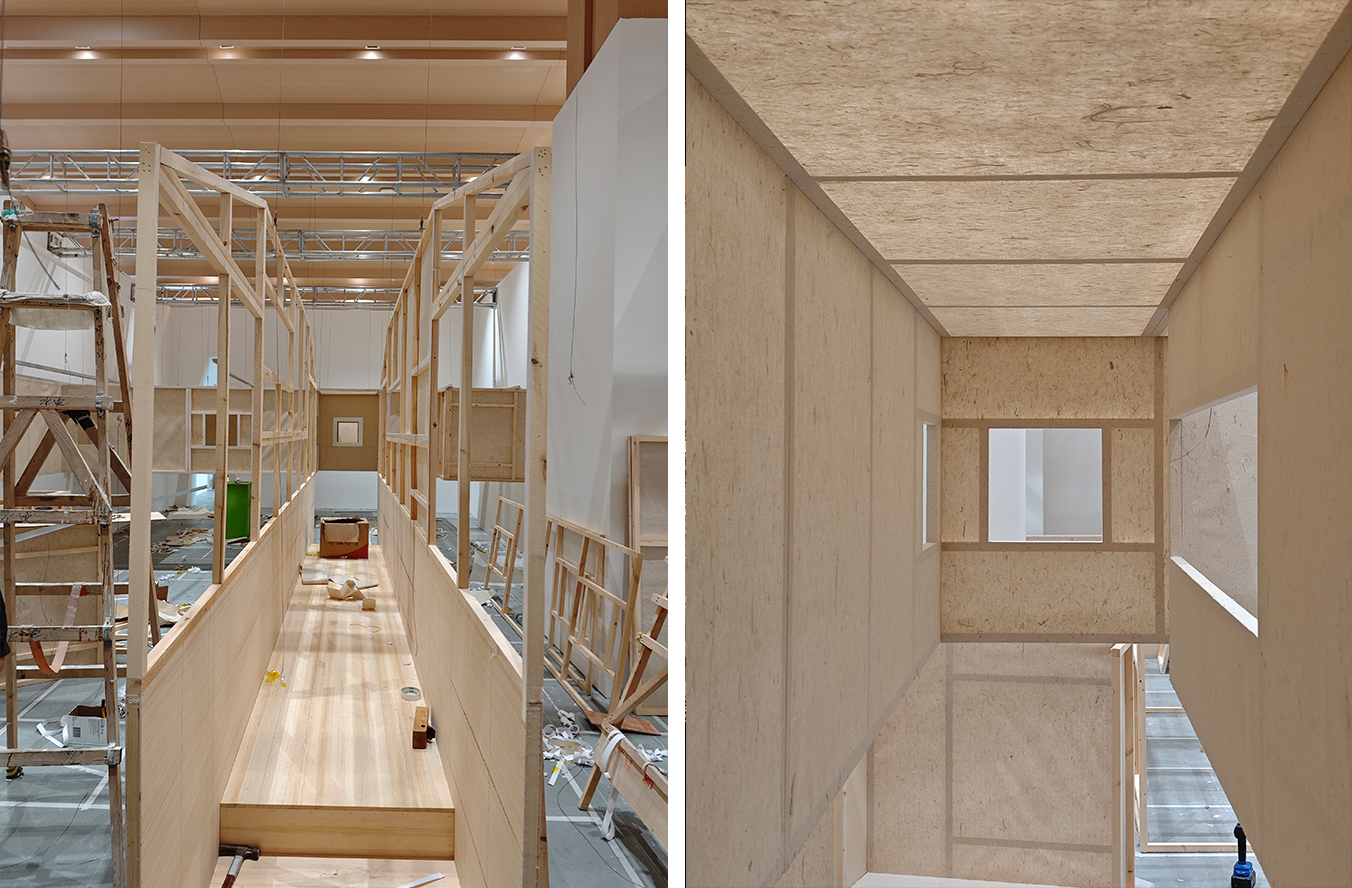



完整项目信息
项目名称:游目园
项目类型:装置
项目地点:上海市松江区云间会堂文化艺术中心
设计时间:2024.6.1—2024.6.15
建设时间:2024.7.1—2024.7.20
用地面积:96平方米
设计单位:c+d设计中心
联系方式:branding@dccd.com.cn
主创建筑师:董屹
设计团队:贺玮玮、华元祺、陈少奇
施工:Art Zhou
业主:松江区文化和旅游局、云间艺术会堂
摄影:c+d设计中心、DC国际
本次展览作品由董屹的装置、吕无咎的绘画共同构成。
助理策展:贺玮玮、华元祺、陈少奇
图片版权:c+d设计中心、DC国际
版权声明:本文由c+d设计中心授权发布。欢迎转发,禁止以有方编辑版本转载。
投稿邮箱:media@archiposition.com
上一篇:游目园|c+d设计中心
下一篇:MOJ咖啡:孪生的水塔 / 偲所设计+澜廷设计